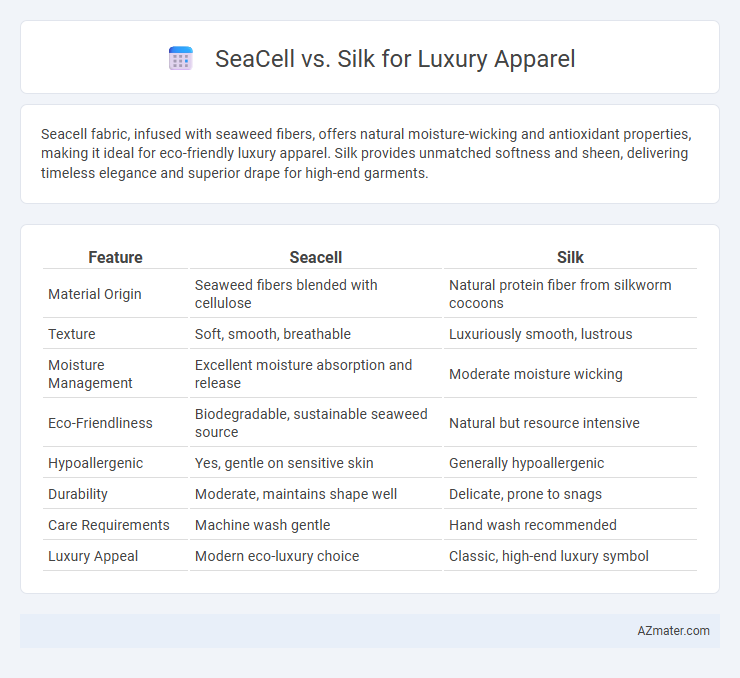Seacell fabric, infused with seaweed fibers, offers natural moisture-wicking and antioxidant properties, making it ideal for eco-friendly luxury apparel. Silk provides unmatched softness and sheen, delivering timeless elegance and superior drape for high-end garments.
Table of Comparison
| Feature | Seacell | Silk |
|---|---|---|
| Material Origin | Seaweed fibers blended with cellulose | Natural protein fiber from silkworm cocoons |
| Texture | Soft, smooth, breathable | Luxuriously smooth, lustrous |
| Moisture Management | Excellent moisture absorption and release | Moderate moisture wicking |
| Eco-Friendliness | Biodegradable, sustainable seaweed source | Natural but resource intensive |
| Hypoallergenic | Yes, gentle on sensitive skin | Generally hypoallergenic |
| Durability | Moderate, maintains shape well | Delicate, prone to snags |
| Care Requirements | Machine wash gentle | Hand wash recommended |
| Luxury Appeal | Modern eco-luxury choice | Classic, high-end luxury symbol |
Introduction to Seacell and Silk Fabrics
Seacell and silk are premium fabrics renowned in luxury apparel for their unique qualities and benefits. Seacell is an innovative fiber derived from seaweed and cellulose, offering natural breathability, moisture-wicking properties, and skin-soothing benefits due to its bioactive components. Silk, produced by silkworms, is prized for its exceptional luster, smooth texture, and superior strength, making it a timeless choice for high-end, elegant garments.
Origins and Production Processes
Seacell, derived from sustainably harvested seaweed and refined into cellulose fibers through an eco-friendly wet spinning process, offers natural bioactive properties ideal for luxury apparel with environmental benefits. Silk, produced by harvesting cocoons of the Bombyx mori silkworm and processed through sericulture and reeling methods, provides a smooth texture and high tensile strength valued in high-end fashion. Both fibers emphasize artisanal craftsmanship, but Seacell integrates maritime resources while silk relies on traditional sericulture practices.
Key Properties of Seacell
Seacell fabric incorporates seaweed fibers that provide natural mineral benefits, moisture-wicking properties, and enhanced breathability, making it ideal for luxury apparel. This sustainable textile offers skin-soothing effects due to its high content of amino acids and antioxidants, distinguishing it from silk's smooth texture and sheen. Unlike silk, Seacell's renewable origin and bioactive components contribute to both comfort and eco-friendly luxury fashion.
Unique Characteristics of Silk
Silk, prized in luxury apparel, offers unmatched natural luster and a smooth, soft texture that enhances both comfort and elegance. Its protein-based fibers provide excellent moisture absorption and breathability, making it suitable for various climates. The unique triangular prism structure of silk refracts light to produce its signature sheen, setting it apart from Seacell's seaweed-infused fibers known for environmentally friendly properties.
Sustainability and Environmental Impact
Seacell fabric, derived from sustainably harvested seaweed combined with organic cotton, offers natural biodegradability and skin-nourishing properties, reducing reliance on synthetic fibers and minimizing landfill waste. Silk production, while luxurious, often involves high water consumption and energy-intensive processes, with traditional sericulture practices raising ethical and environmental concerns. Choosing Seacell over silk in luxury apparel promotes eco-friendly resource use, lower carbon footprints, and enhances circular fashion initiatives through renewable raw materials.
Comfort and Breathability Comparison
Seacell fabric, infused with seaweed fibers, offers exceptional moisture-wicking properties and natural skin-soothing benefits, enhancing comfort and breathability in luxury apparel. Silk, known for its smooth texture and thermal regulation, provides a lightweight and breathable experience but can retain moisture longer compared to Seacell. Choosing Seacell over silk in luxury clothing ensures superior breathability and sustained comfort, especially in warm or active conditions.
Aesthetic Appeal and Fabric Texture
Seacell fabric offers a unique aesthetic appeal with its smooth, slightly lustrous surface that mimics natural fibers, enhancing luxury apparel with a subtle sheen and excellent drape. Silk is renowned for its exceptional softness, natural shine, and fluid texture, creating an elegant and timeless look favored in high-end fashion. Both fabrics provide distinct sensory experiences; Seacell feels silky yet breathable, while silk delivers a sumptuous, cool touch that elevates garment sophistication.
Durability and Care Requirements
Seacell fabric, derived from seaweed and cellulose fibers, offers strong durability and natural antibacterial properties that enhance longevity for luxury apparel. Silk, while renowned for its smooth texture and luster, requires delicate handling with gentle washing and limited exposure to sunlight to maintain its quality. Both materials demand specific care, but Seacell's resistance to odor and moisture often results in easier maintenance compared to silk's sensitivity to water and abrasion.
Price Point and Market Availability
Seacell fabric, known for its eco-friendly seaweed-infused fibers, typically commands a higher price point than silk due to its innovative production process and sustainability appeal. Luxury apparel incorporating Seacell often targets niche markets with consumers prioritizing environmental benefits, limiting its widespread market availability compared to silk. Silk remains more prevalent in global luxury fashion markets due to its long-standing reputation, abundant supply from established sericulture industries, and relatively stable price range.
Choosing the Best for Luxury Apparel
Seacell fabric, infused with seaweed fibers, offers natural moisture-wicking and antioxidant properties that enhance comfort and skin wellness, making it ideal for luxury apparel aimed at health-conscious consumers. Silk provides unmatched softness, sheen, and breathability, maintaining a timeless elegance that defines luxury in high-end fashion collections. When choosing the best fabric for luxury apparel, prioritize Seacell for sustainable wellness benefits and silk for classic luxurious texture and aesthetic appeal.

Infographic: Seacell vs Silk for Luxury Apparel
 azmater.com
azmater.com